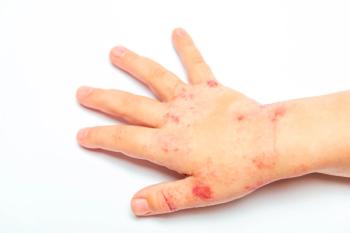
- Consultant for Pediatricians Vol 8 No 10
- Volume 8
- Issue 10
Should this boy’s parents be concerned about the possibility of malignanttransformation in their son’s skin lesion?
The skin lesion pictured here is noted in a 12-year-old boy. His parents state that it developed when he was 1 year of age and that it has been growing with him ever since, with the number of “speckles” seen throughout the light brown background gradually increasing.
Case: The skin lesion pictured here is noted in a 12-year-old boy. His parents state that it developed when he was 1 year of age and that it has been growing with him ever since, with the number of “speckles” seen throughout the light brown background gradually increasing. The parents also say they were told that the lesion was benign and that they did not need to be concerned about any changes that might occur in it.
Was this family given good advice?
No. This benign lesion does have a slight chance of malignant transformation; thus, any change in it cannot be ignored.
This patient’s lesion is a nevus spilus-also known as speckled lentiginous nevus-an acquired benign pigmented skin lesion. It is estimated to occur in 2% of children- equally in boys and girls and in both light-skinned and dark-skinned children. Nevus spilus is usually acquired and develops its pigmented characteristics in early childhood.
Characteristic appearance of nevus spilus. The typical nevus spilus is well demarcated and has an evenly pigmented light brown macular background. It usually measures 2 to 6 cm in diameter, but large (up to 20 cm) lesions are not uncommon.
Multiple 2- to 4-mm macular and papular pigmented lesions are randomly scattered throughout. The lesions often start out with only a few speckles; more appear as the child grows. The diagnosis is almost always clinical.
This boy’s lesion (A) is quite typical-the sort of nevus spilus pediatricians are most likely to see. The second lesion shown here (B) is a more dramatic presentation of nevus spilus in another patient.
Malignant potential is slight-but real. A nevus spilus can be considered benign as long as it retains the characteristic morphology described above. However, malignant transformation is possible. Although the malignant potential of these lesions is not clear, it is certain that it does exist. Thus, changes in a nevus spilus- such as one of the spots in it suddenly becoming darker or raised-cannot be ignored. A recent review of the literature on nevus spilus documented more than 20 reported melanomas occurring within these lesions.1
This is a small number, but it does underscore the importance of regular monitoring and, if possible, of photographic documentation. I reassured this patient’s parents that the chance of a melanoma developing was very remote. However, I also advised them that any change in the nevus should be reported quickly and that a yearly directed review would be best.
Articles in this issue
about 16 years ago
It Takes a Village to Treat ADHD: Community and Clinical Collaborationsabout 16 years ago
Lichen Striatus on the Arm of a 7-Year-Old Girlabout 16 years ago
Herd Immunity:Another Good Reason to Vaccinateabout 16 years ago
Vaccinating theImmunocompromised Childabout 16 years ago
Point-Counterpoint:Responding to Common Reasonsfor Vaccine Refusalabout 16 years ago
Gunshot Woundabout 16 years ago
Henoch-Schönlein Purpura in an 18-Year-Old Boyabout 16 years ago
Pityrosporum Folliculitisabout 16 years ago
Pediatric Immunization Update-2009about 16 years ago
Unusual Lesions-Abuse or Accidental Injury?Newsletter
Access practical, evidence-based guidance to support better care for our youngest patients. Join our email list for the latest clinical updates.








